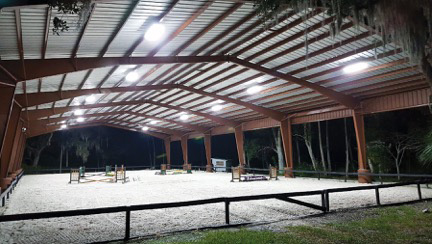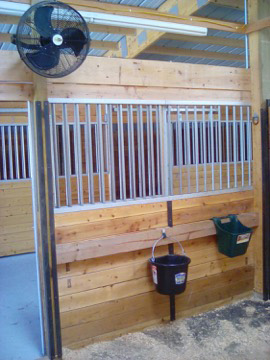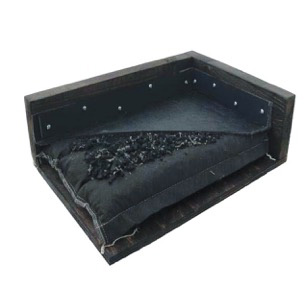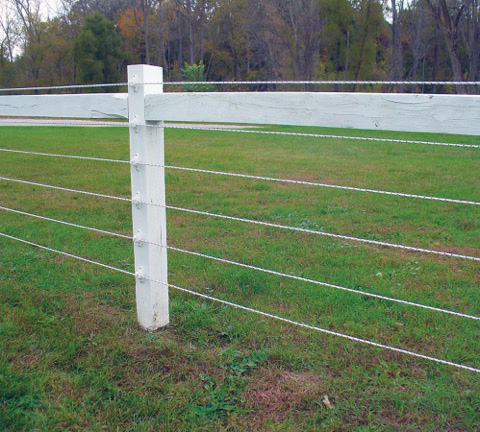|
5-Tips to Tame Winter Horse Chores
We love the seasons, but as horse owners, winter weather makes horse-keeping challenging. Article by Karen Elizabeth Baril
It happens every year, but we never feel ready for it; the return of Old Man Winter. We love the seasons, but as horse owners,
winter weather makes horse-keeping challenging. Between the bitterly cold temperatures, frozen water buckets, and limited daylight, we know we have our work cut out for us.
What helps is to break winter challenges down into manageable bites. What are winter’s biggest challenges? Fresh water, shorter
days, adequate ventilation, fence worries, and farm repairs in cold weather.
Tip 1: Fix Winter Water Worries
Providing fresh water to our horses, whether in their stalls, paddocks, or pastures, is our biggest challenge in cold weather. Unheated
water freezes in minutes, yet we know that water is the most important ingredient in any equine nutrition program. In fact,
veterinarians report that winter colic, due to dehydration, is their most common emergency call. Let’s take a look at our fresh-water options:
•Stock tank de-icers that rest either on the bottom of the tank or float keep the water in the trough or bucket from freezing. There is
a risk of electric shock with these if they are not properly grounded so follow directions explicitly or hire an electrician. Even a small
shock or buzz will discourage horses from drinking water and may keep them from using that trough forever.
•Automatic heated field waterers are usually made of a heavy duty polyethylene construction and work well to keep water from freezing. However, they fail whenever the power is interrupted.
•Livestock post waterers have made keeping cattle in cold weather easy and work even better for horse owners. The post hole
waterer operates like a frost-free hydrant so horses have a constant supply of fresh, clean 50° water year round with no standing
water as you’d find with a trough. This is the most economical, safest, and reliable option for keeping a constant supply of fresh water to horses kept in fields and paddocks.
•Stall options include automatic stall waterers and poly-insulated buckets, both of which work well inside the barn.
Tip 2: Add Daylight Quality Light to the Barn and Arena
Fewer daylight hours and lower light is another winter challenge. Good, daylight quality lighting is essential for veterinarian and farrier
visits, but also it makes those winter horse chores safer and less tedious. While it’s tempting to go to your local home improvement
store to purchase fixtures and bulbs for the barn, it’s a bad idea. Commit to using bulbs and fixtures specifically designed for the dusty and often, damp barn environment.
 •LED high bay arena lights are perfect for the barn or
riding arenas. They’re UL approved and designed for agricultural use. LED high bay arena lights are also cool burning and will turn on without flickering even in cold temperatures. •LED high bay arena lights are perfect for the barn or
riding arenas. They’re UL approved and designed for agricultural use. LED high bay arena lights are also cool burning and will turn on without flickering even in cold temperatures.
•Invest in full spectrum lighting designed for the agricultural and barn environment. A full spectrum bulb consumes just 36 watts of energy yet produces up to 200 watts of light.
The lamps last up to 13 times as long as a standard incandescent bulb. Better lighting, a safer environment, and a more welcoming barn. Full spectrum lighting is often used
to treat seasonal affective disorder in humans and it certainly provides a crisper, clearer, more natural light for all those winter barn tasks.
Tip 3: Keep the Air Flowing
 Barn ventilation becomes even more important in the winter as we close doors and
windows and or horses spend more time indoors. Recurrent airway obstruction (RAO) is now one of the most diagnosed respiratory diseases in horses. Exposure to
respirable particles in the barn, including mold spores, dust, pollens, and ammonia particles can aggravate or even initiate a problem. Barn ventilation becomes even more important in the winter as we close doors and
windows and or horses spend more time indoors. Recurrent airway obstruction (RAO) is now one of the most diagnosed respiratory diseases in horses. Exposure to
respirable particles in the barn, including mold spores, dust, pollens, and ammonia particles can aggravate or even initiate a problem.
•Leave windows and doors open. We might be cold, but our horses are well equipped to handle cooler temperatures without feeling uncomfortable. Ventilation is
far more important to their health than avoiding the chill of winter.
•Install barn fans. If you have room, consider ceiling fans which move air throughout
the interior space, including hard to reach stall corners. Intake/Outtake fans also help to keep the air moving. Quality fans operate efficiently, using less energy than a 100
watt lightbulb. Never use a store-bought house fan for the barn.
Tip 4: Replace worn or shifting stall mats
Studies show that horses stalled on mats or stall mattresses lie down for  longer periods of time, thereby improving joint health. The ThuroBed™ Mattress system’s 12 cells on each mattress are filled with rubber
crumb, so no foam to break down or compact. They are easy to install with just one or two people and they won’t shift in the stall. Horse owners love them. The
advantages to using stall mats or the ThuroBed™ Mattress system are many: longer periods of time, thereby improving joint health. The ThuroBed™ Mattress system’s 12 cells on each mattress are filled with rubber
crumb, so no foam to break down or compact. They are easy to install with just one or two people and they won’t shift in the stall. Horse owners love them. The
advantages to using stall mats or the ThuroBed™ Mattress system are many:
•Minimize ammonia and dust.
•Use less bedding which results in a smaller manure pile.
•No urine seepage so stalls are easier to clean and smell fresher.
•Relieves joint strain.
•No holes or cavities where horses like to stand.
Tip 5: Check Your Fencing, Gates, and Chargers
It’s a good idea to check your fence lines  for repairs before winter strikes. There’s nothing worse than struggling to repair fences or gates with frozen fingers. for repairs before winter strikes. There’s nothing worse than struggling to repair fences or gates with frozen fingers.
•Check your grounding system. Add more ground rods if needed, experts say at least 3 or more 5’ ground rods placed approximately ten feet apart all along the perimeter of your electric fence should be
sufficient depending on the terrain and soil.
•Replace frayed or worn tape with quality electric fencing like Pro-Tek Braided Electric Horse fence or Shockline Flex Fence® from RAMM.
•Check fence lines for weeds, sticks, and low hanging branches that might fall in a storm.
• Replace your old charger with a low impedance charger. Acreage limits will be listed on the charger
unit. Use a unit that is powerful enough for the job.
RAMM Horse Fencing and Stalls is committed to providing quality products and solid information to farm owners.
|